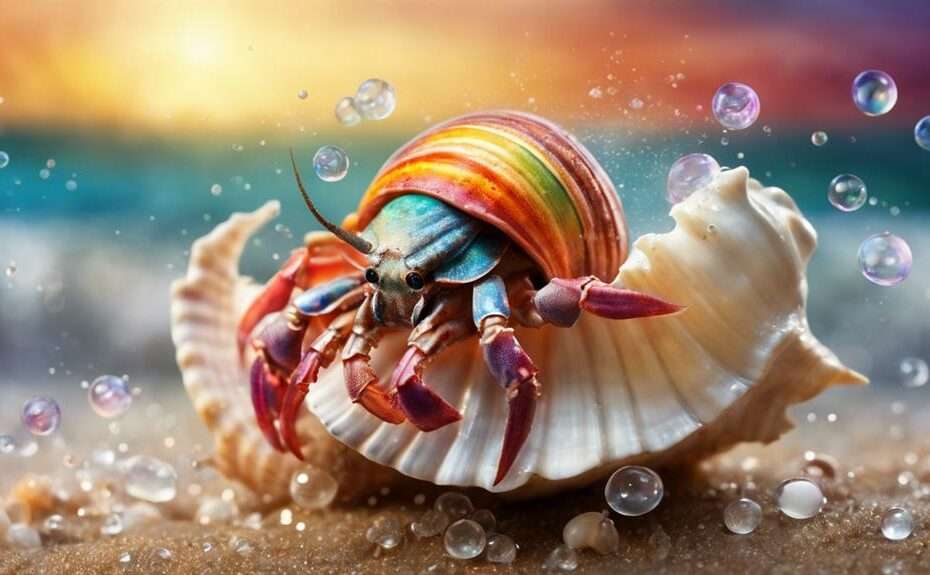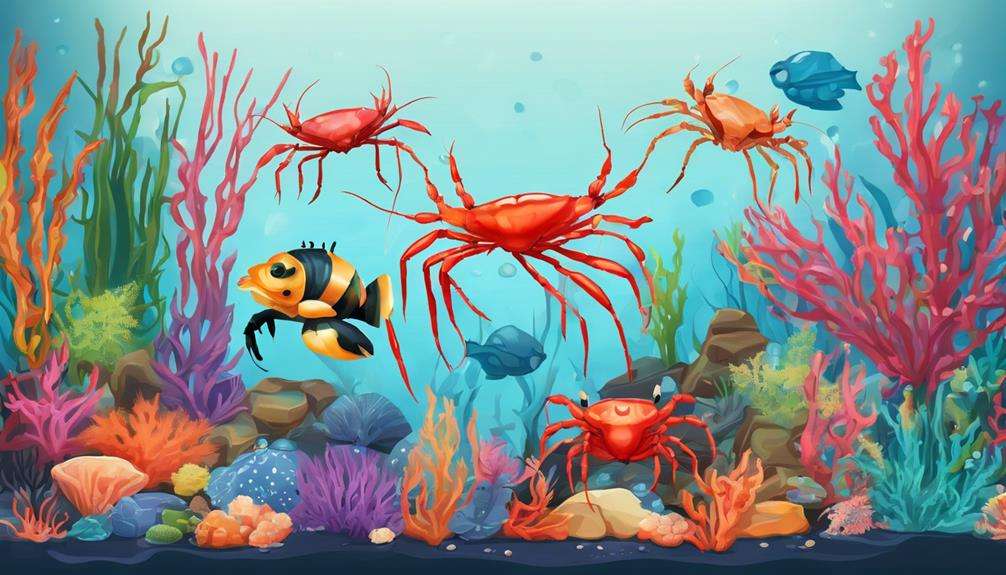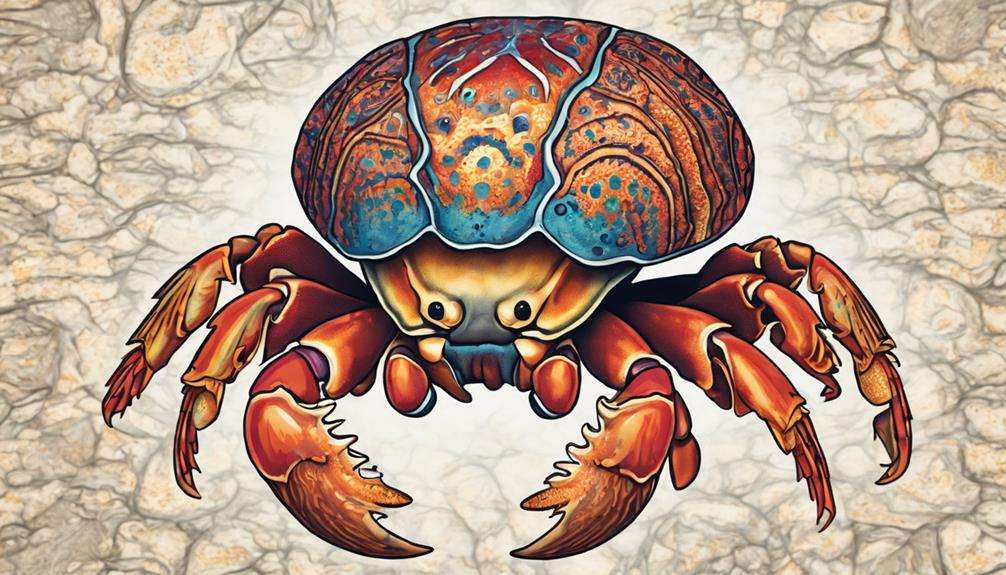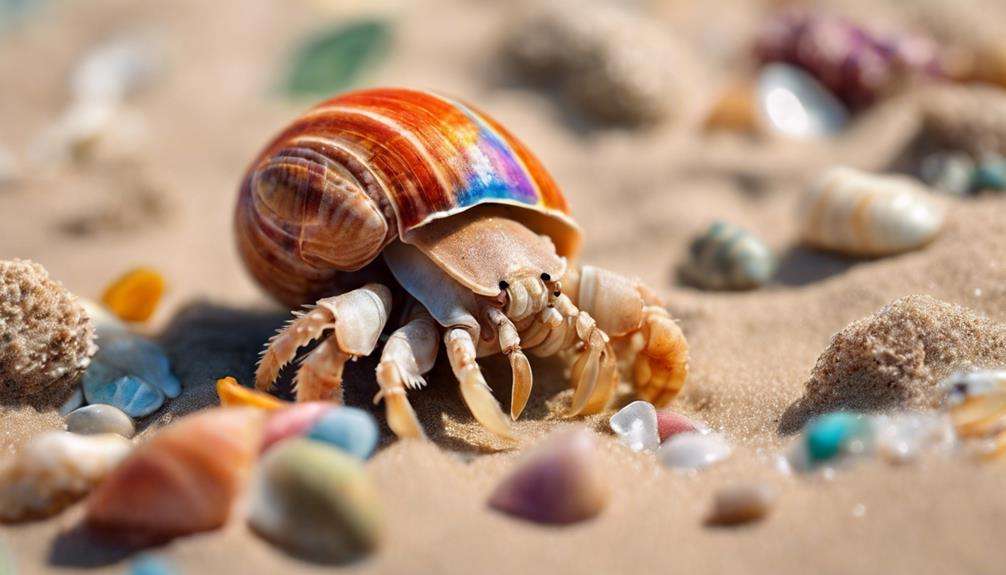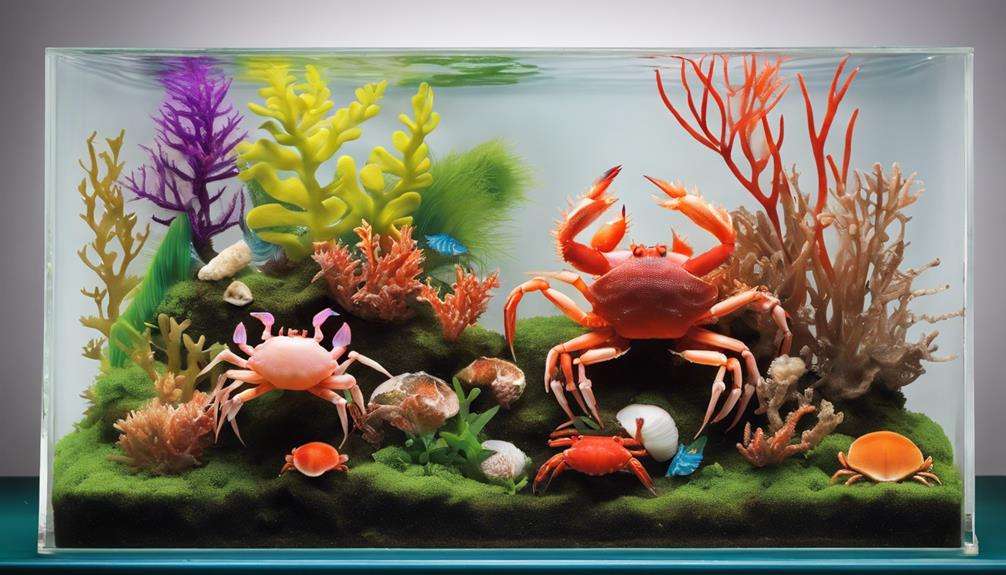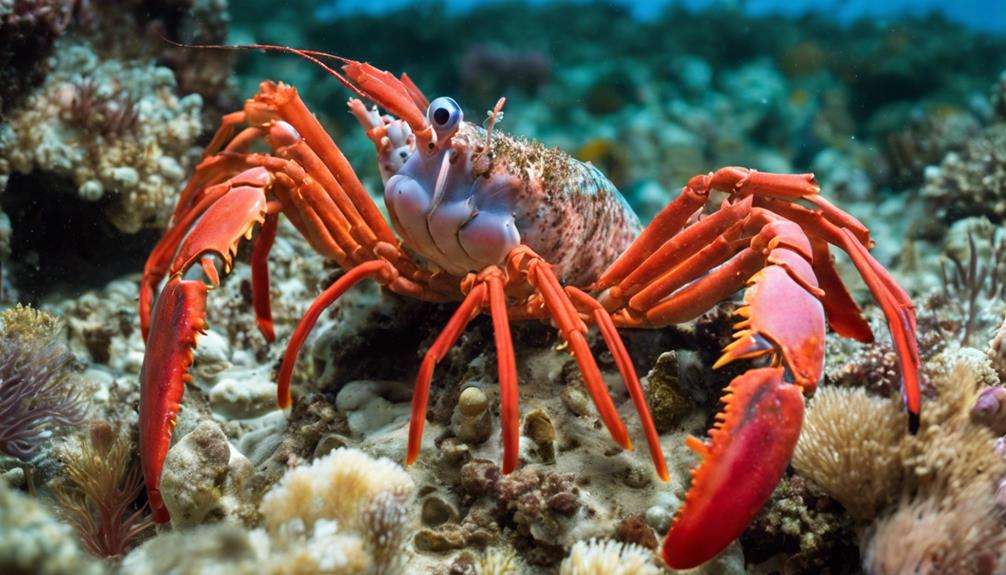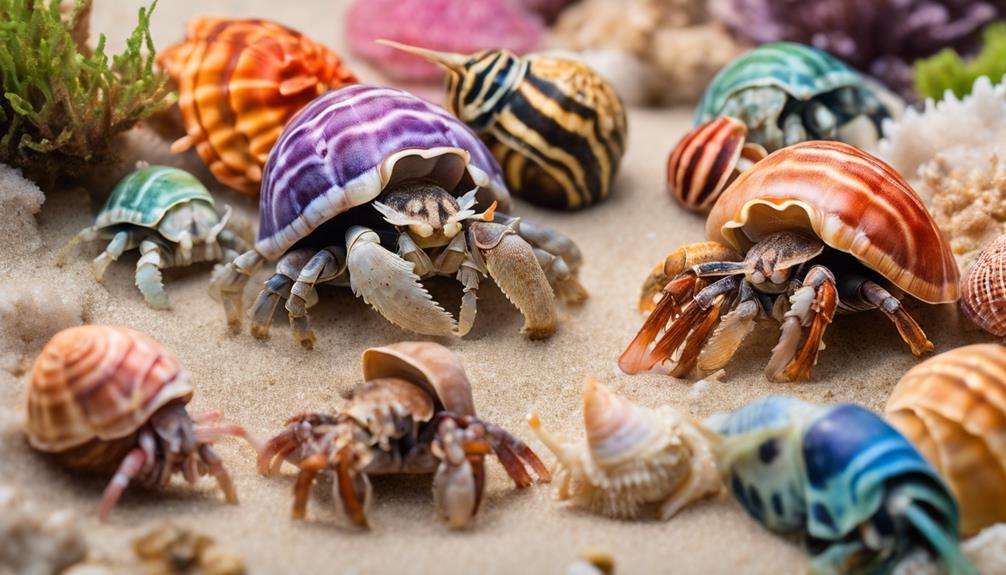When it comes to intriguing topics of conversation, certain crustaceans possess unique qualities that can pique your interest.
Imagine discussing creatures that blend seamlessly into their surroundings, showcasing impressive adaptability and swift movements.
These crustaceans not only captivate with their camouflage skills but also play vital roles in their ecosystems.
As you explore further, you'll discover how these creatures contribute to the delicate balance of nature and offer a window into a fascinating world waiting to be uncovered.
Key Takeaways
- Mantis Shrimp with powerful punch and intricate eyesight make for intriguing discussions.
- Coconut Crab's unique behaviors like tree-climbing captivate attention.
- Boxer Crab's symbiotic relationship with sea anemones sparks curiosity.
- Peacock Mantis Shrimp's striking appearance and hunting prowess are conversation-worthy.
Unique Crustaceans for Engaging Conversations
When engaging in conversations about unique crustaceans, the Mantis Shrimp stands out as a remarkable creature with its powerful punch and intricate eyesight. Found in the wild, these colorful crustaceans thrive in tropical and subtropical waters, preferring areas with sandy or rocky substrates where they can burrow and hide. To care for Mantis Shrimp in captivity, it's essential to recreate their natural living conditions as closely as possible. Providing suitable hiding spots, a varied diet, and maintaining proper water quality are crucial for the well-being of these fascinating creatures.
In the wild, Mantis Shrimp are skilled hunters, using their lightning-fast strikes to catch prey and defend their territory. By mimicking their natural environment in captivity, enthusiasts can observe the impressive hunting behaviors of these wild animals up close. Ensuring good care for Mantis Shrimp involves understanding their unique feeding habits and social behaviors, allowing for a deeper appreciation of their complexity as marine creatures.
Exotic Crustaceans That Spark Interest
Exotic crustaceans, such as the Mantis Shrimp and Coconut Crab, offer a fascinating glimpse into the diverse world of crustacean species.
Their unique behaviors, like the Mantis Shrimp's powerful punch or the Coconut Crab's coconut-cracking claws, showcase the remarkable adaptations these creatures have evolved.
With their vibrant colors and intriguing characteristics, these rare crustaceans are sure to spark interest and ignite conversations about the wonders of the animal kingdom.
Rare Crustacean Species
Rare crustacean species, such as the Boxer Crab, Peacock Mantis Shrimp, Vampire Crab, Pistol Shrimp, and Harlequin Mantis Shrimp, captivate enthusiasts with their unique characteristics and behaviors. These creatures offer plenty of room for exploration and discovery due to their rare nature.
When delving into the world of exotic crustaceans, it's important to remember:
- The Boxer Crab: Known for its symbiotic relationship with sea anemones, providing both protection and camouflage.
- The Peacock Mantis Shrimp: Renowned for its striking appearance and astonishing punching power used for hunting.
- The Vampire Crab: With its dark colors and peculiar feeding habits, it stands out as a captivating species in the aquarium world.
Unique Crustacean Behaviors
Some exotic crustaceans exhibit fascinating behaviors that captivate observers and spark curiosity. For instance, bioluminescent displays in deep-sea environments are a unique feature of certain crustaceans, making them a captivating subject for conversation.
The coconut crab's tree-climbing abilities and its knack for cracking open coconuts with its powerful claws are behaviors that showcase their remarkable adaptability.
Mantis shrimp are intriguing due to their lightning-fast and forceful strikes, capable of breaking aquarium glass. The pistol shrimp stands out for its ability to generate a sonic blast by snapping its specialized claw shut, a behavior that mesmerizes many.
Additionally, decorator crabs, with their camouflage adornments made from materials in their surroundings, exhibit creative behaviors that never fail to spark interesting discussions.
Colorful Crustacean Varieties
Colorful crustacean varieties, such as the Peacock Mantis Shrimp and the Harlequin Shrimp, showcase a mesmerizing array of vibrant hues on their exoskeletons, drawing attention and fascination from observers.
These exotic crustaceans with their unique shell patterns provide a captivating sight, adding vibrancy to underwater ecosystems.
The Rainbow Crab, known for its vivid color palette, contributes to the diversity of colorful crustacean collections. The Electric Blue Crayfish stands out with its striking blue coloration, enhancing the visual appeal of aquariums.
Additionally, the Halloween Moon Crab's dark body adorned with bright orange or yellow markings creates a visually stunning contrast, showcasing the intricate beauty of vibrant species interactions in marine environments.
Conversation-Starter Crustaceans to Consider
Among the diverse array of crustaceans that serve as intriguing conversation starters, the mantis shrimp stands out for its remarkable ability to deliver powerful punches capable of shattering aquarium glass. These fascinating creatures possess specialized club-like appendages that can strike with incredible speed and force, reaching speeds of up to 50 miles per hour.
Moving on to coconut crabs, the largest land-living arthropods, their strong claws enable them to climb trees and crack open coconuts with ease, making them a topic of interest.
Peacock mantis shrimp, on the other hand, exhibit a visual spectacle with their complex eyes containing 12-16 color receptors, allowing them to perceive a vast array of colors that humans cannot.
Fiddler crabs use their oversized claw not only for communication with their peers but also to attract potential mates, showcasing intriguing claw conversations.
Lastly, decorator crabs engage in shell secrets by adorning themselves with materials like algae and sponge, showcasing colorful camouflages that captivate observers.
Each of these crustaceans offers a unique conversation piece, making them excellent choices for sparking engaging discussions.
Standout Crustaceans for Socializing
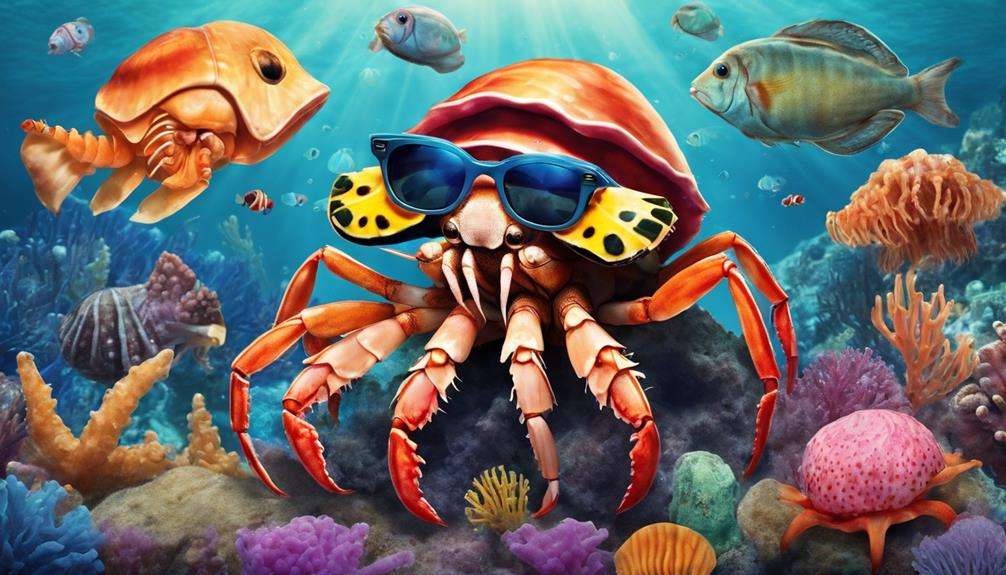
Distinguished by their unique adaptations and captivating behaviors, certain crustaceans excel at initiating engaging conversations in social settings. These standout crustaceans possess vibrant personalities, making them perfect for socializing.
Here are three notable examples:
- Mantis Shrimp: With its incredible speed and powerful punch, the Mantis Shrimp is sure to captivate your audience. Its punchy introductions are bound to spark curiosity and awe, leading to lively discussions about its hunting techniques and vibrant colors.
- Peacock Mantis Shrimp: Known for its vibrant colors and unique eyes, the Peacock Mantis Shrimp is a showstopper in any social setting. Its eye-catching appearance and fascinating behaviors guarantee a memorable encounter, leaving sizeable impressions on those lucky enough to observe it.
- Coconut Crab: This crustacean's massive size and impressive ability to crack coconuts make it a great conversation starter. Its sheer power and intriguing feeding habits are sure to attract attention and admiration, setting the stage for interesting discussions about its ecological role and impressive strength.
Distinct Crustaceans That Impress Guests
Impressing guests with their unique adaptations and captivating behaviors, certain crustaceans stand out as fascinating conversation starters in social settings.
The Mantis Shrimp, with its giant claws capable of delivering a powerful punch, is a standout crustacean that can intrigue guests with its incredible eyesight and hunting techniques.
Another impressive choice is the Peacock Mantis Shrimp, renowned for its vibrant patterns and complex behaviors, making it an ideal topic for discussions about marine life.
The Coconut Crab, as the largest land-living arthropod, captures attention with its sheer size and strength, leaving guests in awe of its impressive features.
Additionally, the Pistol Shrimp's ability to create a sonic boom underwater sets it apart as a remarkable crustacean that's sure to spark curiosity and initiate interesting conversations.
Lastly, the Vampire Crab stands out with its striking appearance and semi-terrestrial nature, making it a distinctive choice to captivate guests and lead to engaging dialogues about these fascinating creatures.
Engaging Crustaceans for Chit-Chat
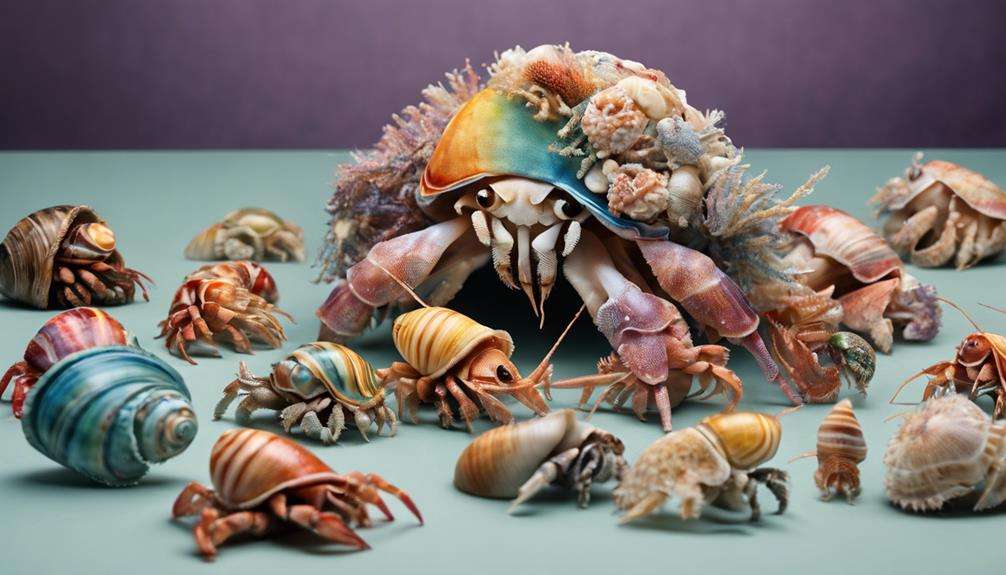
When engaging in chit-chat about crustaceans, consider focusing on their unique shell designs, social behavior patterns, and colorful claw displays.
These aspects not only provide interesting conversation starters but also showcase the diversity and complexity of these fascinating creatures.
Unique Shell Designs
The diverse array of unique shell designs among crustaceans not only serves functional purposes but also provides intriguing conversation starters for those observing these fascinating creatures.
1. Shell diversity, natural marvel
The decorator crab's ability to camouflage by decorating its shell with materials from the environment showcases a remarkable adaptation that astounds onlookers.
2. Camouflage creativity, shell beauty
The Mithrax crab's colorful and spiky shell not only acts as a defense mechanism but also captivates with its beauty, making it a standout feature in aquariums.
3. Protective adaptations, shell uniqueness
The box crab's box-shaped shell offers exceptional protection, enabling it to wedge into crevices for safety, highlighting the species' unique adaptation for survival.
Social Behavior Patterns
Engage with crustaceans' intricate social behavior patterns by observing their fascinating interactions and communication methods, shedding light on the complexity of their social structures.
Shell swapping is a common social behavior among crustaceans like hermit crabs, forming 'crab piles' to exchange shells and conserve moisture.
Claw dominance plays a crucial role in the social dynamics of fiddler crabs, with dominant males sporting larger claws to attract mates and defend territory.
Mating rituals are particularly intriguing in mantis shrimps, involving complex behaviors and visual signals.
Even solitary coconut crabs exhibit social interactions during mating season and territorial disputes.
Lobsters establish dominance hierarchies through aggressive displays within their groups, showcasing the importance of social behavior in these fascinating crustaceans.
Colorful Claw Displays
Colorful claw displays in crustaceans serve as key visual cues for communication and interaction within their social structures.
3 Fascinating Facts about Colorful Claw Displays:
- Vibrant displays, fascinating interactions: Fiddler crabs utilize their colorful claws to attract mates and communicate within their social group, showcasing a remarkable display of colors to convey messages effectively.
- Colorful claws, intriguing behaviors: Species like the pom-pom crab and the porcelain crab use their vibrant claws not only for camouflage and defense against predators but also for intricate social interactions within their communities.
- Eye-catching crustaceans, captivating conversations: Mantis shrimp, known for their colorful claws, employ these striking features for hunting, signaling, and communicating with others, making them visually captivating creatures that spark engaging discussions among enthusiasts.
Frequently Asked Questions
What Questions Should I Ask About Crustaceans?
When learning about crustaceans, ask about their behavior, anatomy, and conservation. Delve into their intricate adaptations, roles in ecosystems, and address misconceptions. These topics spark engaging conversations, leading to a deeper understanding of these fascinating creatures.
What Are the Most Common Crustaceans?
Crustacean diversity is vast, with crabs, lobsters, shrimp, crayfish, and barnacles being the most common. Their interesting behaviors and ecological roles vary, from crabs' widespread presence to shrimp's popularity in seafood cuisine, showcasing their significance in ecosystems.
What Organisms Feed on Crustaceans?
Organisms that feed on crustaceans play crucial roles in marine ecosystems. Predators like octopuses, seals, and sharks rely on crustaceans as a vital food source. These interactions shape complex food webs, highlighting the significance of crustaceans in sustaining biodiversity.
What Does Crustaceans Eat?
Crustaceans have diverse dietary habits, consuming algae, plankton, small fish, mollusks, and detritus. They can be scavengers, omnivores, filter feeders, or predators. These interesting creatures play crucial roles in marine ecosystems with their feeding strategies.
Conclusion
In conclusion, crustaceans like ghost crabs are indeed fascinating conversation starters due to their unique traits and behaviors. Their ability to change color, adapt to land and water, fast burrowing, and sensitivity to vibrations make them intriguing subjects for discussion.
Additionally, their role in the ecosystem as beach cleaners and prey for birds and fish adds depth to conversations about these captivating creatures. Next time you're looking for an engaging topic, consider starting a conversation about these standout crustaceans.
